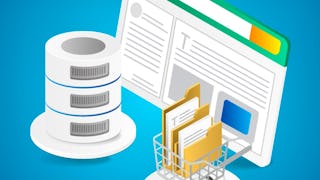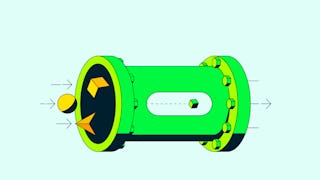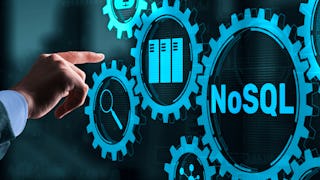"Introduction to MongoDB" guides you through the foundational skills and knowledge you need to get started with MongoDB. Get an introduction to MongoDB Atlas, the developer data platform, and how to create and deploy an Atlas cluster. Discover how MongoDB structures data in documents similar to JSON objects, making it flexible and developer friendly. Learn how to connect to a MongoDB database and perform simple CRUD operations and other key tasks, such as aggregation, indexing, data modeling, transactions, and creating a search experience for the users of your app. By the end of this course, you’ll have the skills you need to start working with MongoDB.



(87 reviews)
Recommended experience
What you'll learn
Create, connect to and manage MongoDB databases
Perform fundamental CRUD operations in MongoDB
Create data models, aggregation pipelines, indexes and transactions
Add a search feature to your application using MongoDB Atlas Search
Details to know

Add to your LinkedIn profile
11 assignments
See how employees at top companies are mastering in-demand skills


Earn a career certificate
Add this credential to your LinkedIn profile, resume, or CV
Share it on social media and in your performance review

There are 11 modules in this course
In this module, you’ll learn about Atlas, MongoDB’s multi-cloud developer data platform. First, you will become familiar with the tools and services that are available to you when you set up an Atlas account. You’ll also learn about how MongoDB Atlas stores and hosts data with Atlas clusters, a global, multi-cloud database service. Finally, you’ll set up a free Atlas account, launch your own free-tier Atlas cluster, and load sample data into your cluster so that you can get started with using MongoDB Atlas and the developer data platform.
What's included
3 videos1 reading1 assignment
In this module you’ll learn how MongoDB stores data and how MongoDB fits into Atlas, the developer data platform. You'll also review common use cases for MongoDB. Next, you'll learn the value types that MongoDB supports, how MongoDB creates unique identifiers, and what it means that MongoDB has a “flexible schema.” Finally, you’ll begin to manage databases, collections, and documents in the MongoDB Atlas Data Explorer. This module will give you a solid foundation in the concepts and skills that you'll need to work with MongoDB.
What's included
4 videos3 readings1 assignment
This module will show you how to connect to MongoDB databases - you'll use MongoDB connection strings, connect to MongoDB with the mongo shell, connect to MongoDB Compass, and learn how to troubleshoot common connection issues.
What's included
6 videos3 readings1 assignment
In this module, you will be introduced to CRUD operations in MongoDB by inserting and finding documents. Inserting and finding documents will help you discover the ease and usability of MongoDB. You'll also build your own queries that use comparison and logical operators. Using operators will make your queries more precise and, in turn, make your application easier to develop. Finally, you'll learn how to query elements in an array. Arrays are a crucial data type that you will encounter frequently, so it's important that you have a solid understanding of how to work with them.
What's included
6 videos6 readings1 assignment
In this module, you’ll learn how to update, replace, and delete documents in MongoDB. These commands will help you manipulate data in your database and will prepare you to build MongoDB into your own apps. We will replace entire documents, update individual fields in a document, insert new documents, and remove documents from a database. By the end of this module, you'll be able to execute most of the common database operations.
What's included
6 videos6 readings1 assignment
In this module, you’ll learn how to modify query results in MongoDB by using sorts, limits, projections, and counts. First, you will learn how to organize query results by sorting and limiting the documents that are returned. Then you'll explore how to use projection to return selected fields from a query. Finally, you’ll learn how to count the number of documents that match a query. Using these query modifications will help enhance the functionality and performance of your applications.
What's included
4 videos4 readings1 assignment
In this module, you will learn about the aggregation pipeline, which is one of MongoDB's most powerful features. You will learn how to use the aggregation pipeline to filter, sort, and organize the data in your collections.
What's included
6 videos5 readings1 assignment
In this module, you will learn about indexes, how indexes support the efficient execution of queries in MongoDB, the trade-offs associated with using indexes, how to create Single Field and Compound Index, what Multikey indexes are, and how to see if queries are using indexes. Finally, you will learn how to delete an index.
What's included
6 videos5 readings1 assignment
Atlas Search allows you to quickly and easily add a search feature to your application. Search can be tricky to tackle, especially if you have a lot of data that you need to sort and filter quickly. MongoDB Atlas has a built-in tool that allows you to add search functionality to your application, and customize the users’ results with weighted values, analyzers, and groupings. This module will show you how to use Atlas Search to customize your searches.
What's included
6 videos3 readings1 assignment
In this module, you will learn the basics of data modeling. Specifically, you'll learn about the purpose of data modeling, the different types of relationships that your data can have and how to model them, and the differences between embedding and referencing. Then, you will learn how to scale your data model and use Atlas Tools for schema help.
What's included
8 videos2 readings1 assignment
In this module, you'll learn about ACID transactions in MongoDB. ACID transactions guarantee that certain database operations, such as the transfer of value from one account to another, succeed together or do not happen not at all. This ensures the integrity of the data in a database. We'll begin with an introduction to ACID transactions. Then, we'll explore how ACID transactions work with the document model in MongoDB. Finally, we'll cover how to create and cancel multi-document transactions in MongoDB.
What's included
4 videos2 readings1 assignment
Instructors


Offered by
Explore more from Data Management
Why people choose Coursera for their career




Learner reviews
87 reviews
- 5 stars
72.72%
- 4 stars
23.86%
- 3 stars
2.27%
- 2 stars
0%
- 1 star
1.13%
Showing 3 of 87
Reviewed on Jan 6, 2025
Nice course. But would be more interactive with skilled speakers.
Reviewed on Jun 30, 2024
I can confidently say that I've learned the basics of MongoDB. Great course.
Reviewed on Jan 31, 2024
Very informative. Some of the examples cannot be followed because the data is not available.
New to Data Management? Start here.

Open new doors with Coursera Plus
Unlimited access to 10,000+ world-class courses, hands-on projects, and job-ready certificate programs - all included in your subscription
Advance your career with an online degree
Earn a degree from world-class universities - 100% online
Join over 3,400 global companies that choose Coursera for Business
Upskill your employees to excel in the digital economy
Frequently asked questions
Access to lectures and assignments depends on your type of enrollment. If you take a course in audit mode, you will be able to see most course materials for free. To access graded assignments and to earn a Certificate, you will need to purchase the Certificate experience, during or after your audit. If you don't see the audit option:
The course may not offer an audit option. You can try a Free Trial instead, or apply for Financial Aid.
The course may offer 'Full Course, No Certificate' instead. This option lets you see all course materials, submit required assessments, and get a final grade. This also means that you will not be able to purchase a Certificate experience.
When you purchase a Certificate you get access to all course materials, including graded assignments. Upon completing the course, your electronic Certificate will be added to your Accomplishments page - from there, you can print your Certificate or add it to your LinkedIn profile. If you only want to read and view the course content, you can audit the course for free.
You will be eligible for a full refund until two weeks after your payment date, or (for courses that have just launched) until two weeks after the first session of the course begins, whichever is later. You cannot receive a refund once you’ve earned a Course Certificate, even if you complete the course within the two-week refund period. See our full refund policy.
More questions
Financial aid available,










